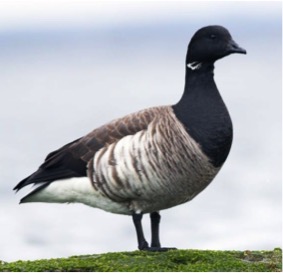
- Appearance: small goose, black head and neck, black beak and eyes, brown wings with black tips, white rump, belly is white with brown stripes across, black webbed feet, in flight white “u” shape seen on rump near tail
- No significant difference between males and females
- Height: about 17-20 inches (1.5 feet)
- Wingspan: 43-47 inches (about 4 feet)
- Status: common, populations stable
- In the 1930s, a disease devastated eelgrass populations, which caused mass starvation for brants and a significant population decline
- Brant is only species of goose that heavily relies on one variety of plant
- Still vulnerable to habitat loss, especially in nesting grounds, and pollution
- In the 1930s, a disease devastated eelgrass populations, which caused mass starvation for brants and a significant population decline
- Habitat
- Arctic, salt bays, estuaries, sometimes visit freshwater lakes and ponds
- Brants nest farthest north of any goose in North America
- Brants have several subspecies: Atlantic (east coast North America), Black (Pacific Coast North America), Gray-bellied (Northern Pacific Coast North America), Dark-bellied (coastal Europe and Asia)
- Diet
- Mostly plant material: in migration and winter eat eelgrass almost exclusively, during breeding season also eat algae, pondweed, grasses, and sedges
- Also eat insects, worms, and mollusks during summer
- Wait for low tide, then wade or paddle in shallow part of water
- Mostly plant material: in migration and winter eat eelgrass almost exclusively, during breeding season also eat algae, pondweed, grasses, and sedges
- Migration
- Usually wait until warm weather (when ice thaws in arctic) to migrate, linger in wintering range longer than most geese
- Only the Atlantic brant overwinters in Long Island
- Migrate from breeding grounds back to wintering grounds at signs of cold weather, as water bodies in tundra begin to freeze
- One of longest migration paths of any goose
- Some fly up about 3,000 miles from Alaska to Mexico
- From the Canadian Arctic, brants fly nonstop down east side of Hudson Bay to Atlantic coast of U.S.
- Use “flyways,” which are common paths for many migratory birds
- No distinguishable formation, unlike other species of geese
- Average flight speed about 40 mph, top speed about 60 mph
- Usually wait until warm weather (when ice thaws in arctic) to migrate, linger in wintering range longer than most geese
- Nesting
- Breeds in loose colonies, which may have dozens to hundreds of brants
- Male and female meet on wintering grounds, mate for life and return to same breeding grounds year after year
- Nest is shallow bowl of vegetation such as moss, lichen, seaweed, and grasses, and is heavily lined with down feathers
- Down = soft feathers underneath a bird’s flight feathers that keep it warm
- Average brood is 3-5 creamy white/pale olive eggs
- Female incubates (sits on) eggs, male protects her
- Goslings leave nest 1-2 days after hatching
- Both parents care for young, lead them to feeding grounds so they can forage independently during long daylight hours of arctic
- Young fledge after 40-50 days
- Juveniles are darker than adults – breasts are gray-brown
- Parents accompany juveniles on their first migration
- Average lifespan is about 5-10 years, but oldest Atlantic brant was 22 years old







